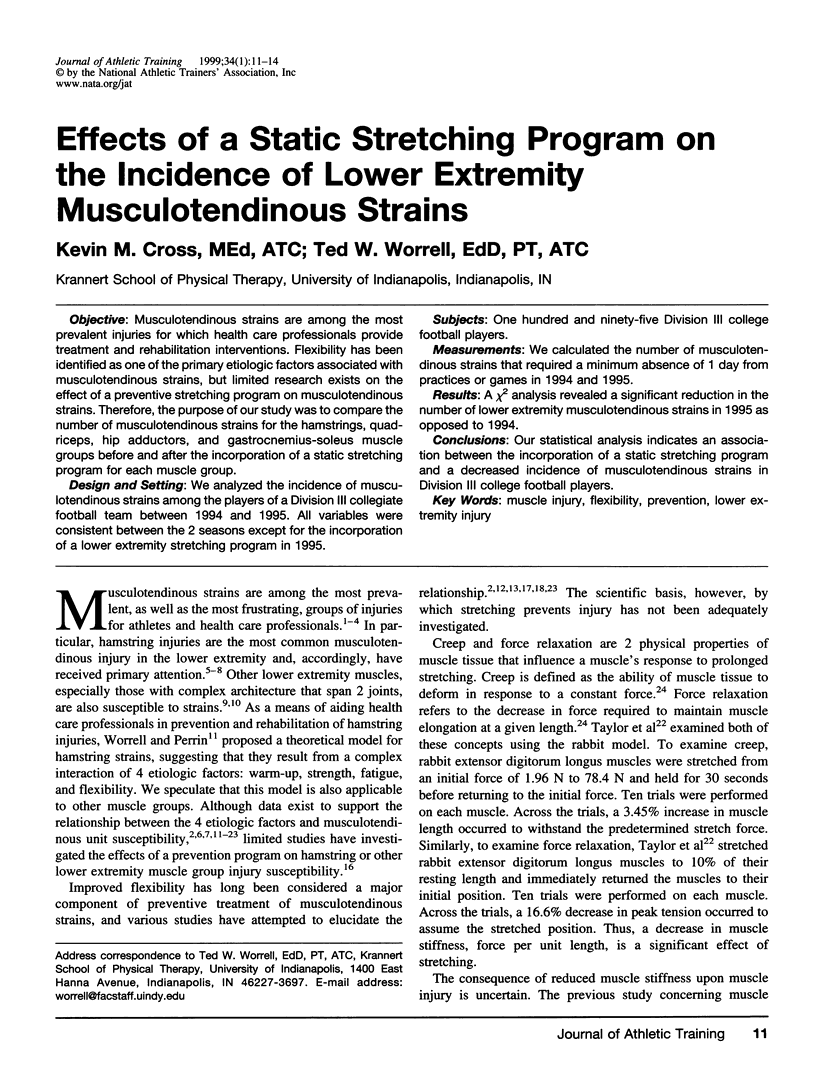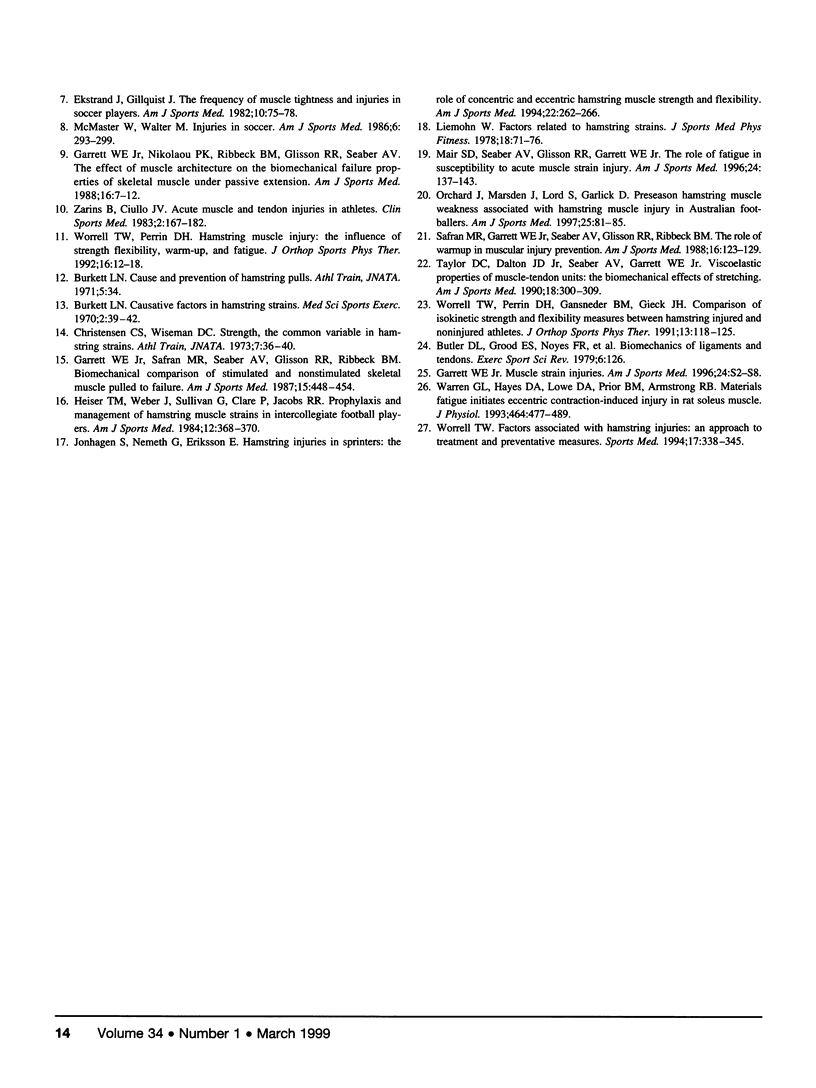Abstract
Objective:
Musculotendinous strains are among the most prevalent injuries for which health care professionals provide treatment and rehabilitation interventions. Flexibility has been identified as one of the primary etiologic factors associated with musculotendinous strains, but limited research exists on the effect of a preventive stretching program on musculotendinous strains. Therefore, the purpose of our study was to compare the number of musculotendinous strains for the hamstrings, quadriceps, hip adductors, and gastrocnemius-soleus muscle groups before and after the incorporation of a static stretching program for each muscle group.
Design and Setting:
We analyzed the incidence of musculotendinous strains among the players of a Division III collegiate football team between 1994 and 1995. All variables were consistent between the 2 seasons except for the incorporation of a lower extremity stretching program in 1995.
Subjects:
One hundred and ninety-five Division III college football players.
Measurements:
We calculated the number of musculotendinous strains that required a minimum absence of 1 day from practices or games in 1994 and 1995.
Results:
A x² analysis revealed a significant reduction in the number of lower extremity musculotendinous strains in 1995 as opposed to 1994.
Conclusions:
Our statistical analysis indicates an association between the incorporation of a static stretching program and a decreased incidence of musculotendinous strains in Division III college football players.
Keywords: muscle injury, flexibility, prevention, lower extremity injury
Full text
PDF



Selected References
These references are in PubMed. This may not be the complete list of references from this article.
- Brubaker C. E., James S. L. Injuries to runners. J Sports Med. 1974 Jul-Aug;2(4):189–198. doi: 10.1177/036354657400200402. [DOI] [PubMed] [Google Scholar]
- Burkett L. N. Causative factors in hamstring strains. Med Sci Sports. 1970 Spring;2(1):39–42. [PubMed] [Google Scholar]
- Canale S. T., Cantler E. D., Jr, Sisk T. D., Freeman B. L., 3rd A chronicle of injuries of an American intercollegiate football team. Am J Sports Med. 1981 Nov-Dec;9(6):384–389. doi: 10.1177/036354658100900608. [DOI] [PubMed] [Google Scholar]
- Ekstrand J., Gillquist J. The frequency of muscle tightness and injuries in soccer players. Am J Sports Med. 1982 Mar-Apr;10(2):75–78. doi: 10.1177/036354658201000202. [DOI] [PubMed] [Google Scholar]
- Garrett W. E., Jr Muscle strain injuries. Am J Sports Med. 1996;24(6 Suppl):S2–S8. [PubMed] [Google Scholar]
- Garrett W. E., Jr, Nikolaou P. K., Ribbeck B. M., Glisson R. R., Seaber A. V. The effect of muscle architecture on the biomechanical failure properties of skeletal muscle under passive extension. Am J Sports Med. 1988 Jan-Feb;16(1):7–12. doi: 10.1177/036354658801600102. [DOI] [PubMed] [Google Scholar]
- Garrett W. E., Jr, Safran M. R., Seaber A. V., Glisson R. R., Ribbeck B. M. Biomechanical comparison of stimulated and nonstimulated skeletal muscle pulled to failure. Am J Sports Med. 1987 Sep-Oct;15(5):448–454. doi: 10.1177/036354658701500504. [DOI] [PubMed] [Google Scholar]
- Heiser T. M., Weber J., Sullivan G., Clare P., Jacobs R. R. Prophylaxis and management of hamstring muscle injuries in intercollegiate football players. Am J Sports Med. 1984 Sep-Oct;12(5):368–370. doi: 10.1177/036354658401200506. [DOI] [PubMed] [Google Scholar]
- Jönhagen S., Németh G., Eriksson E. Hamstring injuries in sprinters. The role of concentric and eccentric hamstring muscle strength and flexibility. Am J Sports Med. 1994 Mar-Apr;22(2):262–266. doi: 10.1177/036354659402200218. [DOI] [PubMed] [Google Scholar]
- Knapik J. J., Bauman C. L., Jones B. H., Harris J. M., Vaughan L. Preseason strength and flexibility imbalances associated with athletic injuries in female collegiate athletes. Am J Sports Med. 1991 Jan-Feb;19(1):76–81. doi: 10.1177/036354659101900113. [DOI] [PubMed] [Google Scholar]
- Liemohn W. Factors related to hamstring strains. J Sports Med Phys Fitness. 1978 Mar;18(1):71–76. [PubMed] [Google Scholar]
- Mair S. D., Seaber A. V., Glisson R. R., Garrett W. E., Jr The role of fatigue in susceptibility to acute muscle strain injury. Am J Sports Med. 1996 Mar-Apr;24(2):137–143. doi: 10.1177/036354659602400203. [DOI] [PubMed] [Google Scholar]
- Orchard J., Marsden J., Lord S., Garlick D. Preseason hamstring muscle weakness associated with hamstring muscle injury in Australian footballers. Am J Sports Med. 1997 Jan-Feb;25(1):81–85. doi: 10.1177/036354659702500116. [DOI] [PubMed] [Google Scholar]
- Safran M. R., Garrett W. E., Jr, Seaber A. V., Glisson R. R., Ribbeck B. M. The role of warmup in muscular injury prevention. Am J Sports Med. 1988 Mar-Apr;16(2):123–129. doi: 10.1177/036354658801600206. [DOI] [PubMed] [Google Scholar]
- Taylor D. C., Dalton J. D., Jr, Seaber A. V., Garrett W. E., Jr Viscoelastic properties of muscle-tendon units. The biomechanical effects of stretching. Am J Sports Med. 1990 May-Jun;18(3):300–309. doi: 10.1177/036354659001800314. [DOI] [PubMed] [Google Scholar]
- Warren G. L., Hayes D. A., Lowe D. A., Prior B. M., Armstrong R. B. Materials fatigue initiates eccentric contraction-induced injury in rat soleus muscle. J Physiol. 1993 May;464:477–489. doi: 10.1113/jphysiol.1993.sp019646. [DOI] [PMC free article] [PubMed] [Google Scholar]
- Worrell T. W. Factors associated with hamstring injuries. An approach to treatment and preventative measures. Sports Med. 1994 May;17(5):338–345. doi: 10.2165/00007256-199417050-00006. [DOI] [PubMed] [Google Scholar]
- Zarins B., Ciullo J. V. ACute muscle and tendon injuries in athletes. Clin Sports Med. 1983 Mar;2(1):167–182. [PubMed] [Google Scholar]


